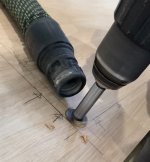Crazyraceguy
Member
- Joined
- Oct 16, 2015
- Messages
- 5,435
It could be made repeatable, but unless you need to do it frequently, may not be worth the effort.
Looks good though. It not that often that we see such instant results.
The Dominos as skis on the MFK700 is a good idea. Glad it all worked out.
Looks good though. It not that often that we see such instant results.
The Dominos as skis on the MFK700 is a good idea. Glad it all worked out.



